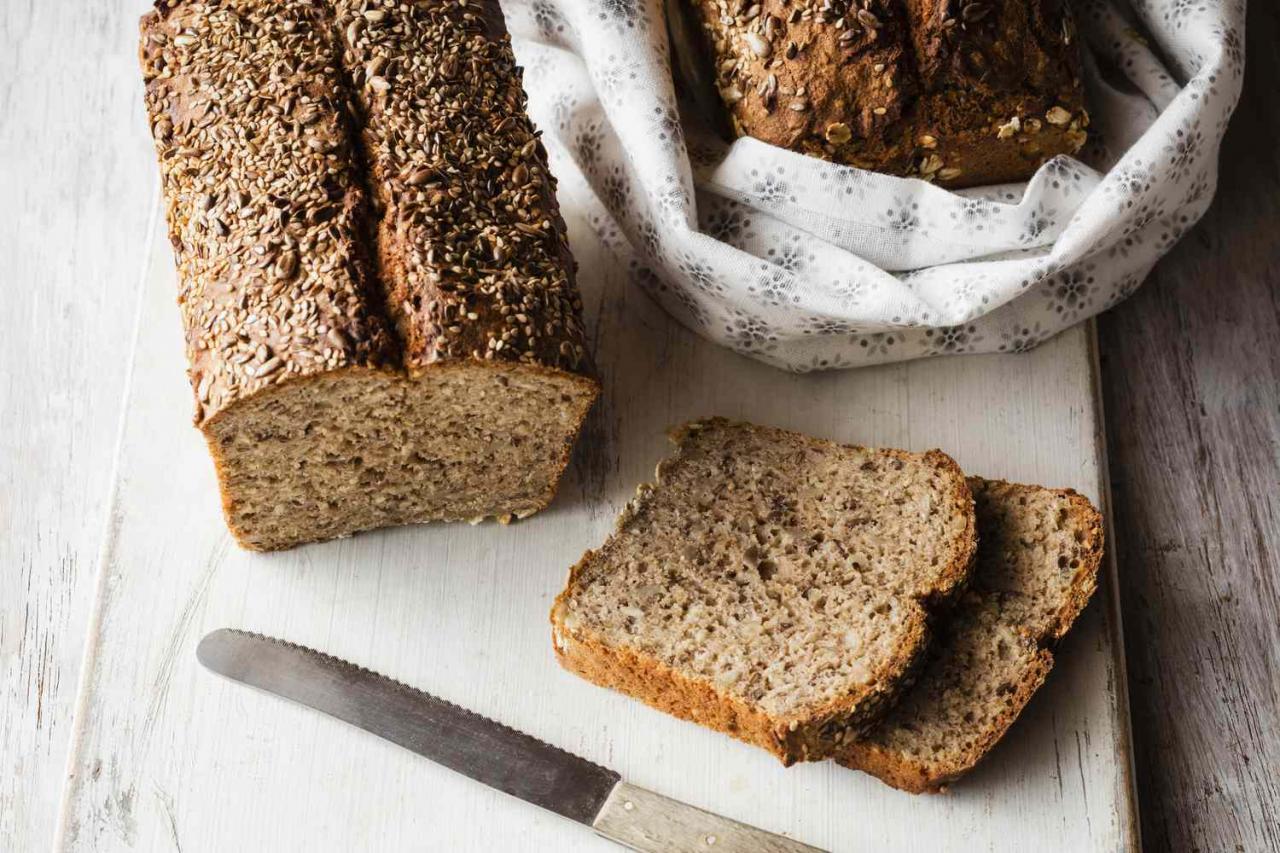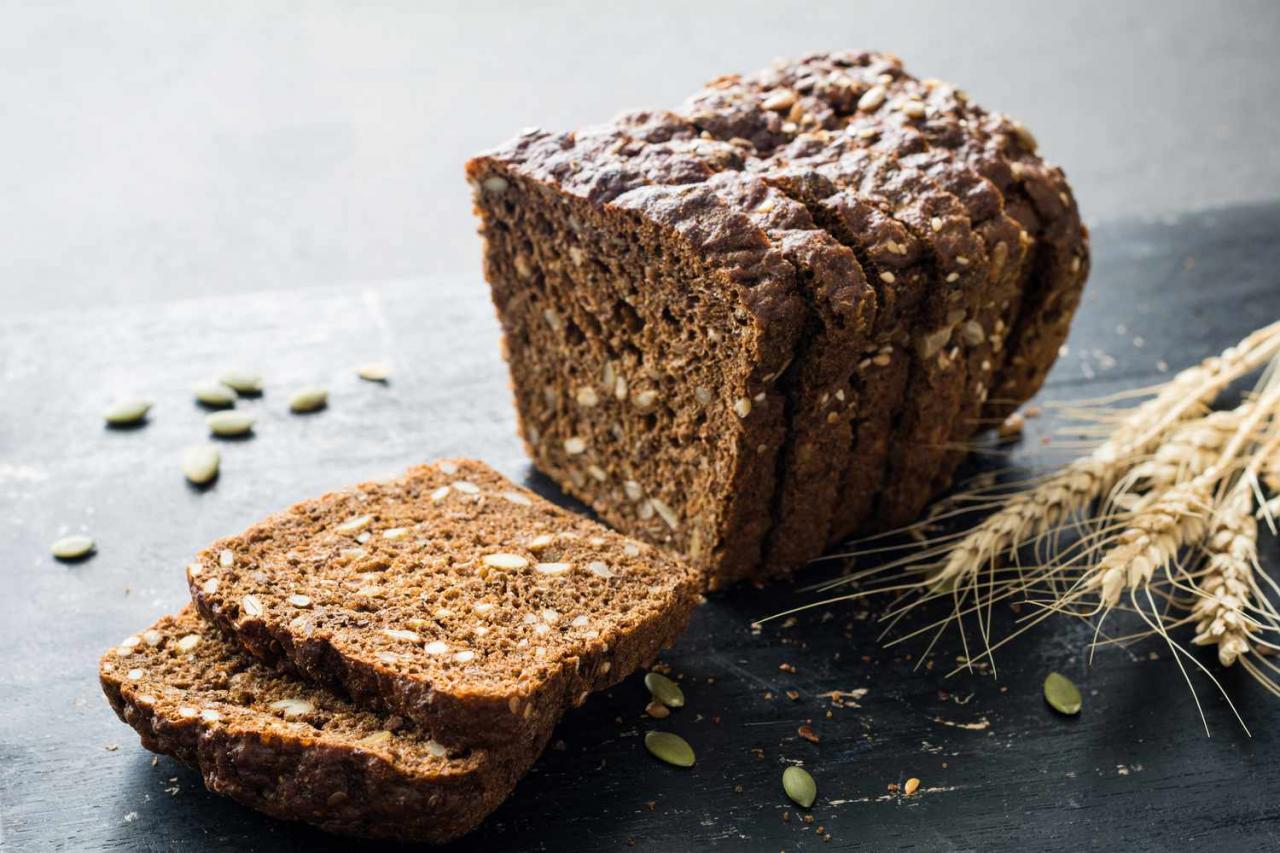Carbohydrates, also known as carbs, are sugar molecules and one of the three main nutrient sources, along with the other macronutrients: fat and protein. Our body relies on carbs as its primary energy source, especially for the brain and nervous system. So, how do we get these essential carbs?
We get our carbs from three main types: sugars (which occur naturally in fruits and are found in sugary processed foods), starches (such as bread, potatoes, and pasta), and fiber or roughage, which is the indigestible part of carbs that helps maintain good gut and heart health, as well as blood sugar levels.
Bread is a great carbohydrate choice, given its versatility and its availability. Keep reading to learn more about the healthiest breads to eat and how to choose a healthier loaf for your diet.
Sprouted Grain Bread 
Westend61 / Getty Images
Sprouted bread is made from whole grains that have sprouted in a carefully controlled environment. Normally, grains are dormant, but sprouted grains have begun to sprout.
Whole grains contain all parts of the grain—bran, germ, and endosperm—providing more nutrients and antioxidants (more on this in the next section). Eating whole grains as part of a healthy diet can support digestive health, reduce the risk of heart disease, and help with weight management.
When grains are sprouted, their nutrients become more bioavailable, making them easier to absorb.
Sprouted grains also contain higher quantities of essential amino acids. Amino acids are the essential building blocks of proteins and essential amino acids cannot be produced by the body and must be obtained from food.
The nutritional information for sprouted grain bread and other breads mentioned below may vary based on the brand and serving size. A single slice of sprouted grain bread (39 grams) contains 100 calories, 4.02 grams of protein, 18 grams of carbohydrates, and 3 grams of fiber.
Whole Wheat Bread 
Stefka Pavlova / Getty Images
Whole grain bread utilizes all three parts of the grain. The outer layer of the grain, or the bran, contains antioxidants, fiber, and B vitamins. The germ is rich in B vitamins, minerals, and healthy fats. The endosperm provides starchy carbs, protein, and small amounts of vitamins and minerals.
On the other hand, refined grains have their bran and germ removed, leaving only the starchy endosperm. This process removes a quarter of the protein and two-thirds or more of the essential nutrients. To make up for the loss, refined grain is enriched, but with fewer than a half dozen of the many missing nutrients. This is a reason why dietary guidelines suggest that half of our grain intake should come from whole grains.
Whole wheat is one kind of whole grain. One slice (32 grams) of whole wheat bread provides 80.6 calories, 3.97 grams of protein, 13.7 grams of carbs, and 1.92 grams of fiber.
Whole Rye Bread 
Arx0nt / Getty Images
Rye bread is made from rye, which is a type of wheat crop. Rye has a high level of fiber in its endosperm, not just in the bran. Plus, the type of fiber in rye promotes rapid satiety or a feeling of fullness.
As a result of its high fiber content, rye products typically have a lower glycemic index compared to wheat and most other grain products. Glycemic index (GI) is a measure of how quickly a food raises blood sugar. In general, low GI foods raise blood sugar slowly and high GI foods raise blood sugars quickly. Eating low GI is beneficial for effectively managing blood sugar levels, especially for people with diabetes.
It's important to understand that the term "rye" on bread labels doesn't necessarily indicate it's a whole grain bread. To ensure you're choosing a whole grain option, seek out "whole rye" listed in the ingredients.
A slice of whole rye bread (71 grams) provides 140 calories, 4 grams of protein, 33 grams of carbs, and 7.03 grams of fiber.
Whole Grain Bread with Seeds 
Juanmonino / Getty Images
Whole grain bread with seeds, such as flaxseed, pumpkin seed, or sunflower seed, is typically made from whole wheat or sprouted whole wheat.
The addition of seeds can improve the flavor and texture of bread, giving it a chewy and nutty taste that some may enjoy. It can also increase the bread's protein and fiber content. For example, a slice (45 grams) of organic whole wheat bread with a seed mix provides 110 calories, 5 grams of protein, 18 grams of carbs, and 5.98 grams of fiber.
It’s recommended to include enough fiber in the diet since it can promote fullness, help with weight management, prevent constipation, lower cholesterol, and keep blood sugar levels normal. For reference, we need 14 grams of fiber for every 1,000 calories consumed. Opting for bread with higher fiber content can help you meet your daily fiber requirements.
Gluten-Free Whole Grain 
Westend61 / Getty Images
Gluten-free whole grain bread is intended for people with celiac disease or gluten sensitivity and made without gluten-containing ingredients. Gluten is a type of protein that can be found in certain grains such as wheat, rye, and barley. If someone has celiac disease or gluten sensitivity, they must avoid gluten because it can trigger negative reactions.
Gluten-free whole grain breads typically contain starches such as brown rice, tapioca starch, and potato starch as the primary ingredient. They may include gluten-free grains such as millet, teff, and quinoa. Some gluten-free whole grain breads may also add seeds such as flax or sesame.
One slice (25 grams) of gluten-free whole grain bread made with tapioca starch and brown rice flour provides 77.2 calories, 1.81 grams of protein, 12.3 grams of carbs, and 1.22 grams of fiber.
Oat Bread 
Anna Pustynnikova / Getty Images
Oat bread is a healthy option due to oats’ health benefits. Beta-glucan, a type of fiber in oats, is the primary compound that helps reduce cholesterol levels and manage blood sugar levels. Eating oats has also been shown to have positive effects on the immune system and gut microbiota.
The primary flour used in oat bread is typically enriched wheat flour or whole grain flour, such as whole wheat or whole barley. The next ingredients are water and oats.
One slice (45 grams) of oat bread provides 120 calories, 5 grams of protein, 23 grams of carbs, and 0.98 grams of fiber.
Sourdough Bread 
Food style and photography / Getty Images
Sourdough bread does not use commercial yeast. It's made through a fermentation process that uses naturally occurring bacteria and yeast in the flour. The process results in a tangy and chewy bread that has an extended shelf-life.
The process of fermenting sourdough bread can significantly reduce the amount of FODMAP (Fermentable Oligo-, Di-, Mono-saccharides And Polyols) content, which makes it easier to digest the bread. FODMAPs are short-chain carbohydrates that some people find hard to digest, leading to bloating, discomfort, and other digestive problems. Therefore, sourdough bread can be beneficial for people with digestive issues such as irritable bowel syndrome.
Another benefit of sourdough bread is its lower glycemic index (GI) value compared to white bread, which can be beneficial for blood sugar management. It's important to note research on the full spectrum of sourdough's health benefits is limited and ongoing.
A 1-ounce (28.35 grams) portion of sourdough bread provides 77.1 calories, 3.06 grams of protein, 14.7 grams of carbs, and 0.624 grams of fiber.
Multigrain Bread 
zia_shusha / Getty
Multigrain bread is made of two or more different types of grains, such as wheat, barley, millet, and quinoa. If the grains used are 100% whole grains, multigrain bread can provide more fiber.
However, it can be difficult to determine if a multigrain bread is made with whole grain. To ensure that the bread is made with whole grain, check the label for the words "whole wheat" or another whole grain listed as the first ingredient.
A medium-sized slice (36 grams) of multigrain bread provides 95.4 calories, 4.82 grams of protein, 15.6 grams of carbs, and 2.66 grams of fiber.
How to Find a Healthier Bread
When you're out shopping, here are some tips to keep in mind for choosing a healthier bread option. Remember to compare options to find the ones with the most favorable nutritional profile.
Read the ingredient list:Look for “whole wheat” or another whole grain listed first in the ingredients list.Avoid lists where refined grains such as “enriched wheat flour” come first.Check the fiber content:Aim for at least 2-3 grams of fiber per slice.Limit added sugars:Steer clear of breads with added sugars,often listed as “sugar,” “high fructose corn syrup,” or “honey.”Healthy extras: Extra ingredients such as seeds, nuts, and legumes (beans, peas, lentils) can boost the nutritional profile and flavor.Look in the refrigerated section of the grocery store: Breads with less preservatives and more healthy fats tends to go bad faster, so they should be stored in the fridge or freeze to prolong its shelf life.Look for the Whole Grains Council seal: This symbol features a sheaf of grain on a golden-yellow background with a bold black border helps consumers identify products with a significant amount of whole grains. It also showshow many grams of whole grain ingredients are in a serving of the product. For example, a 100% stamp means that all the grains in the product are 100% whole grain. A 50% stamp means at least half of the grain ingredients in a product arewholegrain. A Quick Review
This diverse list of the healthiest breads provides options for every preference, from whole-wheat classics to flavorful seed-studded loaves, and even caters to gluten-free needs. Follow our handy shopping list to navigate the bread aisle. Remember, healthy bread is just one piece of the puzzle—enjoy it alongside a balanced diet and mindful eating!